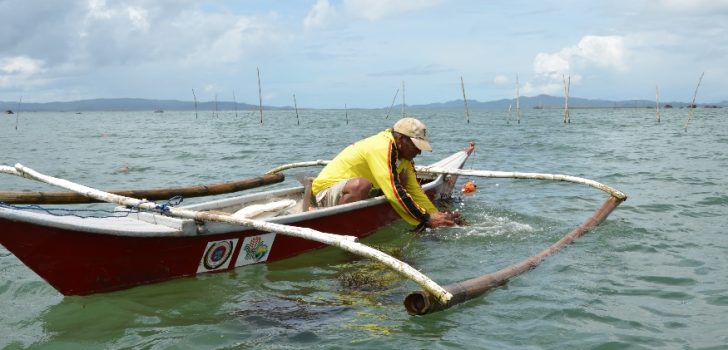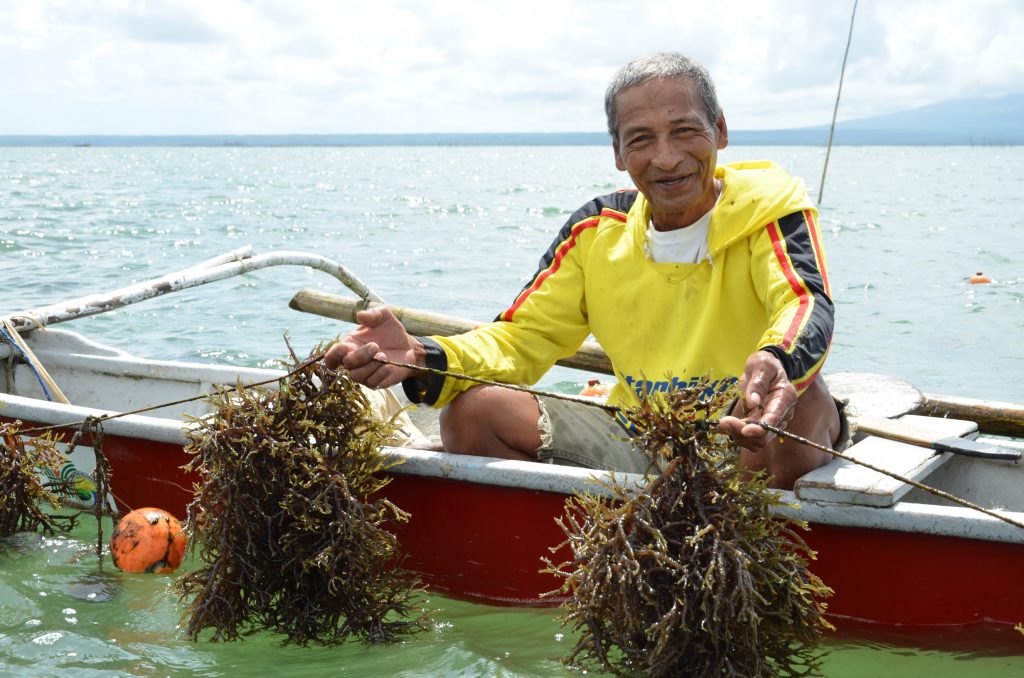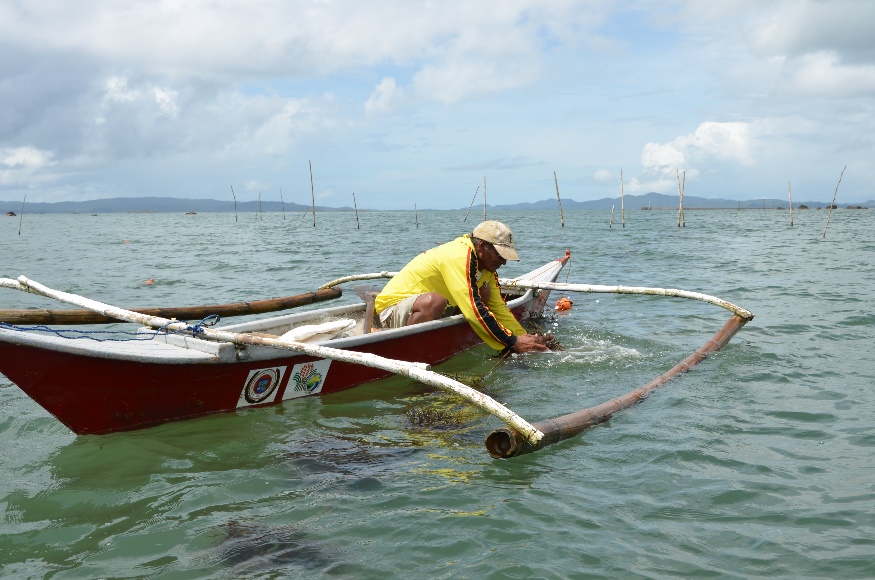 Every day at 2 a.m., SAMAGI seaweed farmer-member Santos Janoras goes to sea to clean his seaweed by shaking the tie line to rid off the dirt and crabs clinging on the seaweeds. (Photo by Hermito Antonio Privaldos, DA-PRDP RPCO V InfoACE Unit)
Every day at 2 a.m., SAMAGI seaweed farmer-member Santos Janoras goes to sea to clean his seaweed by shaking the tie line to rid off the dirt and crabs clinging on the seaweeds. (Photo by Hermito Antonio Privaldos, DA-PRDP RPCO V InfoACE Unit) PRDP-funded seaweed microenterprise restores livelihood of typhoon-affected fisherfolk in Sorsogon
SORSOGON CITY – At 2 a.m., 67-year-old Santos Janoras of Brgy. Pamurayan, Sorsogon rises up and sails to Sorsogon Bay. There, before daybreak, he starts cleaning his 30-meter seaweed farm.
“Dati ang pagtrabaho ko sa pag-tricycle, bumitiw na ako sa pag-tricycle. Ngayon nagtanim na lang ng seaweeds. Nakabangon ako pagkatapos ng bagyong Nona dahil natulungan ng pagsi-seaweeds sa pagtanim. Pag binenta namin ang seaweeds, maganda na pagkalipas ng dalawang buwan nakakabenta mula tres mil (P3,000) hanggang singko mil (P5,000) (I used to work as a tricycle driver. I quit driving and shifted to seaweed farming. I was able to bounce back after Typhoon Nona because of seaweed farming. It is good because every two months, we can sell our seaweeds and earn between P3,000 and P5,000),” Janoras said with a big smile on his face.
Janoras is one of the 74 members of the Samahang Mangingisda ng Gimaloto (SAMAGI) that benefited from the Philippine Rural Development Project’s (PRDP) microenterprise (ME) subprojects for typhoon-affected areas in Sorsogon. He was among the fisherfolk in Sorsogon who lost their properties—house, boat, and other valuable things—when Typhoon Nona hit the province in December 2015. Before the typhoon, SAMAGI members were engaged in fishing and catching blue crabs where they earn an average of P1,600 monthly.
The P1.25 million-worth SAMAGI Seaweed Production and Marketing is a start-up ME subproject under the PRDP’s enterprise development (I-REAP) component. It is designed to improve the seaweed production in the area by providing additional production materials and equipment thereby, restoring the livelihood of the typhoon-affected fisherfolk. Seven SAMAGI members will maintain 10 modules measuring 2,500 square meters each.
The seaweed production period from October to May has at least three to four croppings at 60-day growing period. The expected yield is 2.7 metric tons per harvest per module; hence, the production volume is estimated to be between 120 and 130 metric tons of raw dried seaweeds per year. Through the subproject, the annual income of farmers is expected to increase by 68% from P6,400 to P19,926.
In 2017, PRDP delivered 10 non-motorized fiberglass boats, 25,000 kilograms of seaweed propagules, and 100 rolls of polyethylene rope to SAMAGI. PRDP also provided 50 kilograms of monofilament, 50 rolls of soft tie plastic straw, 100 kilograms of plastic bottle floaters, and 500 sandbags. By second quarter of 2018, PRDP targets to deliver one weighing scale with 1,000 kilogram capacity and one motorized fiberglass boat to the cooperative.
“Dati kapag malaki ang tubig hindi makapaglinis kasi walang masakyan, ngayon okay na dahil may nasi-service na. Anytime na makaisip kami maglinis, nakakapaglinis kami (Before, we can’t easily clean our seaweeds during high tide because we don’t have service boats. Now, we can clean our seaweed area anytime we want),” said SAMAGI President Mariano Saldy Jesoro
He furthered that with the buying price of fresh seaweeds pegged at P20 per kilogram and raw dried seaweeds at P50 per kilogram, most members of SAMAGI were able to invest their income in fishing nets while others, like Janoras, were able to finance the rehabilitation of their typhoon-damaged houses.
Jesoro proudly said that he considers Janoras as the best seaweed farmer in the cooperative. Looking at Janoras as an example, many fisherfolk and residents in Brgy. Pamurayan and Peñafrancia in Sorsogon were encouraged to join SAMAGI. As of February 2018, 15 new members joined the cooperative.
“Nabago ang pamumuhay namin dahil nadagdagan ang kita ng mga mangingisda. Pagdating dito ng seaweeds, nadadagdagan ang hanap-buhay namin. Pag bagyo naaapektuhan talaga ang kita ng mga mangingisda kasi kapag maulan, di ka naman makakapunta sa laot kasi malamig tapos malakas ang alon. Dahil binagyo, magsisikap uli para magtuloy-tuloy ang pag-asenso. Nagpapasalamat ako dahil nabigyan kami ng biyaya—natulungan kami ng PRDP sa paghahanap-buhay (Our lives have changed because fisherfolk like us gained higher income through this seaweed project. Typhoons greatly affect fisherfolk’s source of livelihood. During rainy days, we cannot go out fishing because it’s cold and ocean currents are strong. Since typhoons are inevitable, we’ll persevere again to sustain our progress. I am thankful for this blessing that we received. PRDP helped us by providing a source of livelihood),” Janoras shared.
The SAMAGI Seaweed Production and Marketing is one of the 10 approved PRDP-funded microenterprise subprojects in Sorsogon. ### (Annielyn L. Baleza, DA-PRDP Bicol RPCO InfoACE Unit)

Seaweed farmer Santos Janoras shows the seaweeds that are ready for harvest in his 30-meter seaweed farm in Brgy. Pamurayan, Sorsogon City. (Photo by Hermito Antonio Privaldos, DA-PRDP RPCO V InfoACE Unit)

